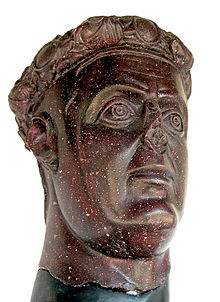Galerius
| Galerius | |||||
|---|---|---|---|---|---|
| Hoàng đế thứ 53 của Đế quốc La Mã | |||||
 Porphyry bust of Galerius | |||||
| Tại vị | 1 tháng 3 hoặc 21 tháng 5 năm 293[1][2]:4, 38[3]:288[4]:146[5]:64–5[6] – 1 May 305 (as Caesar, under Diocletian)[7] 1 May 305 – late April or early May 311 (as Augustus alongside Constantius (until July 25, 306) then Severus (until spring 307) then Constantine (from ca. September 307; unrecognized by Galerius' coinage from ca. September 307 to November 308) then Licinius (from 11 November 308))[2]:4–6 | ||||
| Tiền nhiệm | Maximianus và Diocletianus[7] | ||||
| Kế nhiệm | Maximinus, Constantine, và Licinius[2]:7 | ||||
| Thông tin chung | |||||
| Sinh | ca. 260[2]:37, 46 Serdica[8] (Sofia, Bulgaria) | ||||
| Mất | Cuối tháng 4 hoặc đầu tháng 5 năm 311 (51 tuổi)[9] Serdica (Sofia), Bulgaria | ||||
| An táng | Serdica hoặc Felix Romuliana (Gamzigrad)[10] | ||||
| Phối ngẫu | Galeria Valeria[2]:38 | ||||
| Hậu duệ | Candidianus | ||||
| |||||
| Thân mẫu | Romula (alleged)[2]:37–8 | ||||
Galerius (tiếng Latin: Gaius Galerius Valerius Maximianus Augustus,[11] khoảng năm 260 - tháng 4 hoặc tháng 5 năm 311), là Hoàng đế La Mã trong giai đoạn từ năm 305 đến năm 311 [12] Trong triều đại của mình, ông đã tiến hành chiến dịch chống lại Đế chế Sassanid, với sự trợ giúp của Diocletianus, và cướp phá kinh đô Ctesiphon của họ vào năm 299. Ông cũng tiến hành chiến dịch chống lại người Carpi ở phía bên kia bờ sông Danube, đánh bại họ vào năm 297 và trong năm 300. Mặc dù là một người đối nghịch mạnh mẽ với Kitô giáo, nhưng chính Galerius đã kết thúc cuộc bức hại do Diocletianus khởi xướng qua việc ban hành một sắc lệnh khoan dung vào năm 311.
Đầu đời
[sửa | sửa mã nguồn]Galerius đã được sinh ra ở Serdica,[13] mặc dù một số học giả hiện đại xem xét địa điểm chiến lược nơi sau này ông cho xây dựng một cung điện mang tên người mẹ của ông - Felix Romuliana (Gamzigrad) - nơi sinh và nơi chôn cất ông [10] Cha ông là một người Thracia và mẹ ông, Romula là một phụ nữ Dacia, bà đã rời bỏ Dacia vì các cuộc tấn công của người Carpi [14]:19 Ban đầu ông nối nghiệp cha mình, đó là một người chăn bò, mà nhờ đó ông đã nhận được tên họ của mình, Armentarius (tiếng Latin: armentum).
Ông đã phục vụ trong quân đội dưới triều đại của hoàng đế Aurelianus và Probus. Trong năm 293, khi chế độ Tứ Đầu chế được thiết lập, ông đã được chỉ định là Caesar cùng với Constantius Chlorus,và cưới con gái của Diocletianus, Valeria (sau này được biết là Galeria Valeria), và cùng thời điểm đó, ông được trao quyền cai quản các tỉnh Illyria. Sau một vài năm tiến hành các chiến dịch chống lại người Sarmatia và người Goth trên khu vực sông Danube, ông đã được giao quyền chỉ huy các quân đoàn trên biên giới phía đông của đế quốc. Ngay sau khi được bổ nhiệm, Galerius được phái tới Ai Cập để dập tắt cuộc khởi nghĩa ở các thành phố Busiris và Coptos.[15]
Cuộc chiến tranh với Ba Tư
[sửa | sửa mã nguồn]Xâm lược và phản công
[sửa | sửa mã nguồn]Năm 294, Narseh, người con trai vốn không được kế vị ngai vàng nhà Sassanid của vua Shapur I, đã cướp ngôi vua Ba Tư. Narseh có thể đã sát hại vua Bahram III, vốn còn quá trẻ khi được một quý tộc tên là Vahunam đưa lên ngai vàng ngay sau khi vua Bahram II qua đời vào năm 293 [3]:292[5]:69Vào đầu năm 294, trong khi Narser gửi cho Diocletianus các gói quà tặng theo phong tục, thì ở Ba Tư, ông ta đã phá hủy mọi dấu vết của những vị vua tiền nhiệm ngay lập tức, tẩy xoá tên của họ khỏi những đài tưởng niệm công cộng. Ông ta đã cố gắng để đồng nhất bản thân mình với những triều đại hiếu chiến của vua Ardahir I (r. 226-41) và Shapur (r. 241-72), vị vua đã cướp phá thành Antioch của người La Mã và bắt hoàng đế Valerianuslàm tù binh.[5]:69–70
Trong năm 295 hoặc năm 296, Narseh tuyên bố chiến tranh với Rome. Trước tiên, Ông ta dường như đã xâm lược phía Tây Armenia, lấy lại các vùng đất vốn được giao cho Tiridates theo hiệp ước òa bình năm 287. Ông ta sẽ chiếm các vùng đất đó cho đến tận năm sau [3][4]:149[16][17]:292 Nhà sử học cổ đại Ammianus Marcellinus là tác giả duy nhất duy nhất đề cập một cách chi tiết về cuộc xâm lược Armenia lúc ban đầu này[18] Southern(1999, 149) đặt thời điểm cho cuộc xâm lược là vào năm 295; Barnes (1982, 17, 293) đề cập đến một cuộc xâm lược khác sớm hơn, một cuộc xâm lược không thành công của Narseh dựa trên thực tế rằng tiêu đề Persici Maximi đã được trao cho tất cả bốn vị hoàng đế; Odahl (2004, 59) đồng tình với Barnes và cho rằng các vị hoàng tử Saracen trong sa mạc Syria đã hợp tác với cuộc xâm lược của Narseh. Narseh sau đó di chuyển về phía nam tiến vào vùng Lưỡng Hà của La Mã, tại nơi đó ông ta đã đánh cho Galerius thua hết lần này tới lần khác, mà vào lúc đó Galerius lại đang chỉ huy của các đạo quân phía Đông, ở khu vực giữa Carrhae (Harran, Thổ Nhĩ Kỳ) và Callinicum (Ar-Raqqah, Syria)[17]. Diocletianus lúc đó có thể có hoặc không có mặt tại mặt trận,[3]:652
Tham khảo
[sửa | sửa mã nguồn]Nguồn cổ đại
[sửa | sửa mã nguồn]- Codex Theodosianus.
- Mommsen, T. and Paul M. Meyer, eds. Theodosiani libri XVI cum Constitutionibus Sirmondianis et Leges novellae ad Theodosianum pertinentes2 (in Latin). Berlin: Weidmann, [1905] 1954. Complied by Nicholas Palmer, revised by Tony Honoré for Oxford Text Archive, 1984. Prepared for online use by R.W.B. Salway, 1999. Preface, books 1–8. Online at University College London Lưu trữ 2009-08-26 tại Wayback Machine and the University of Grenoble Lưu trữ 2010-06-18 tại Wayback Machine. Truy cập ngày 25 tháng 8 năm 2009.
- Unknown edition (in Latin). Online at AncientRome.ru. Truy cập ngày 15 tháng 8 năm 2009.
- Epitome de Caesaribus.
- Banchich, Thomas M., trans. A Booklet About the Style of Life and the Manners of the Imperatores. Canisius College Translated Texts 1. Buffalo, NY: Canisius College, 2009. Online at De Imperatoribus Romanis. Truy cập ngày 15 tháng 8 năm 2009.
- Eusebius of Caesarea.
- Historia Ecclesiastica (Church History).
- McGiffert, Arthur Cushman, trans. Church History. From Nicene and Post-Nicene Fathers, Second Series, Vol. 1. Edited by Philip Schaff and Henry Wace. Buffalo, NY: Christian Literature Publishing Co., 1890. Revised and edited for New Advent by Kevin Knight. Online at New Advent. Truy cập ngày 25 tháng 8 năm 2009.
- Vita Constantini (Life of Constantine).
- Richardson, Ernest Cushing, trans. Life of Constantine. From Nicene and Post-Nicene Fathers, Second Series, Vol. 1. Edited by Philip Schaff and Henry Wace. Buffalo, NY: Christian Literature Publishing Co., 1890. Revised and edited for New Advent by Kevin Knight. Online at New Advent. Truy cập ngày 25 tháng 8 năm 2009.
- Festus. Breviarium.
- Banchich, Thomas M., and Jennifer A. Meka, trans. Breviarium of the Accomplishments of the Roman People. Canisius College Translated Texts 2. Buffalo, NY: Canisius College, 2001. Online at De Imperatoribus Romanis. Truy cập ngày 15 tháng 8 năm 2009.
- Lactantius. De Mortibus Persecutorum (On the Deaths of the Persecutors).
- Fletcher, William, trans. Of the Manner in Which the Persecutors Died. From Nicene and Post-Nicene Fathers, Second Series, Vol. 7. Edited by Alexander Roberts, James Donaldson, and A. Cleveland Coxe. Buffalo, NY: Christian Literature Publishing Co., 1886. Revised and edited for New Advent by Kevin Knight. Online at New Advent. Truy cập ngày 25 tháng 8 năm 2009.
- XII Panegyrici Latini (Twelve Latin Panegyrics).
- Nixon, C.E.V., and Barbara Saylor Rodgers, ed. and trans. In Praise of Later Roman Emperors: The Panegyrici Latini. Berkeley: University of California Press, 1994.
- Zosimus. Historia Nova (New History).
- Unknown, trans. The History of Count Zosimus. London: Green and Champlin, 1814. Online at Tertullian. Truy cập ngày 15 tháng 8 năm 2009.[notes 1]
Nguồn hiện đại
[sửa | sửa mã nguồn]- Banchich, Thomas M. "Iulianus (c. 286–293 AD)." De Imperatoribus Romanis (1997). Truy cập ngày 8 tháng 3 năm 2008.
- Barnes, Timothy D. "Lactantius and Constantine." The Journal of Roman Studies 63 (1973): 29–46.
- Barnes, Timothy D. Constantine and Eusebius. Cambridge, MA: Harvard University Press, 1981. ISBN 978-0-674-16531-1
- Barnes, Timothy D. The New Empire of Diocletian and Constantine. Cambridge, MA: Harvard University Press, 1982. ISBN 0-7837-2221-4
- Bleckmann, Bruno. "Diocletianus." In Brill's New Pauly, Volume 4, edited by Hubert Cancik and Helmut Schneider, 429–38. Leiden: Brill, 2002. ISBN 90-04-12259-1
- Bowman, Alan K., Peter Garnsey, and Averil Cameron. The Cambridge Ancient History, Volume XII: The Crisis of Empire. Cambridge University Press, 2005. ISBN 0-521-30199-8
- Brown, Peter. The Rise of Western Christendom. Oxford: Blackwell Publishing, 2003. ISBN 0-631-22138-7
- Burgess, R.W. "The Date of the Persecution of Christians in the Army". Journal of Theological Studies 47:1 (1996): 157–158.
- Canduci, Alexander. Triumph and Tragedy: The Rise and Fall of Rome's Immortal Emperors. Pier 9, 2010. ISBN 978-1-74196-598-8
- Corcoran, Simon. The Empire of the Tetrarchs: Imperial Pronouncements and Government, AD 284–324. Oxford: Clarendon Press, 1996. ISBN 0-19-815304-X
- Corcoran, "Before Constantine", Simon. "Before Constantine." In The Cambridge Companion to the Age of Constantine, edited by Noel Lenski, 35–58. New York: Cambridge University Press, 2006. Hardcover ISBN 0-521-81838-9 Paperback ISBN 0-521-52157-2
- DiMaio, Jr., Michael. "Constantius I Chlorus (305–306 AD) Lưu trữ 2012-02-04 tại Wayback Machine." De Imperatoribus Romanis (1996a). Truy cập ngày 8 tháng 3 năm 2008.
- DiMaio, Jr., Michael. "Galerius (305–311 AD)." De Imperatoribus Romanis (1996b). Truy cập ngày 8 tháng 3 năm 2008.
- DiMaio, Jr., Michael. "Maximianus Herculius (286–305 AD)." De Imperatoribus Romanis (1997). Truy cập ngày 8 tháng 3 năm 2008.
- Elliott, T. G. The Christianity of Constantine the Great. Scranton, PA: University of Scranton Press, 1996. ISBN 0-940866-59-5
- Gibbon, Edward, 'Decline and Fall of the Roman Empire', Chapter 14
- Harries, Jill. Law and Empire in Late Antiquity. Cambridge: Cambridge University Press, 1999. Hardcover ISBN 0-521-41087-8 Paperback ISBN 0-521-42273-6
- Helgeland, John. "Christians and the Roman Army A.D. 173–337." Church History 43:2 (1974): 149–163, 200.
- Jones, A.H.M. The Later Roman Empire, 284–602: A Social, Economic and Administrative Survey. Baltimore: Johns Hopkins University, 1986.
- Lenski, Noel. "The Reign of Constantine." In The Cambridge Companion to the Age of Constantine, edited by Noel Lenski, 59–90. New York: Cambridge University Press, 2006b. Hardcover ISBN 0-521-81838-9 Paperback ISBN 0-521-52157-2
- Mackay, Christopher S. "Lactantius and the Succession to Diocletian." Classical Philology 94:2 (1999): 198–209.
- Mathisen, Ralph W. "Diocletian (284–305 AD.)." De Imperatoribus Romanis (1997). Truy cập ngày 16 tháng 2 năm 2008.
- Odahl, Charles Matson. Constantine and the Christian Empire. New York: Routledge, 2004. Hardcover ISBN 0-415-17485-6 Paperback ISBN 0-415-38655-1
- Pohlsander, Hans. The Emperor Constantine. London & New York: Routledge, 2004a. Hardcover ISBN 0-415-31937-4 Paperback ISBN 0-415-31938-2
- Pohlsander, Hans. "Constantine I (306 – 337 AD)." De Imperatoribus Romanis (2004b). Truy cập ngày 16 tháng 12 năm 2007.
- Potter, David S. The Roman Empire at Bay: AD 180–395. New York: Routledge, 2005. Hardcover ISBN 0-415-10057-7 Paperback ISBN 0-415-10058-5
- Rees, Roger. Diocletian and the Tetrarchy. Edinburgh: Edinburgh University Press, 2004. ISBN 0-7486-1661-6
- Southern, Pat. The Roman Empire from Severus to Constantine. New York: Routledge, 2001. ISBN 0-415-23944-3
- Rostovtzeff, Michael. The Social and Economic History of the Roman Empire. Oxford: Oxford University Press, 1966. ISBN 978-0-19-814231-7
- Treadgold, Warren. A History of the Byzantine State and Society. Stanford: Stanford University Press, 1997. ISBN 0-8047-2630-2
- Williams, Stephen. Diocletian and the Roman Recovery. New York: Routledge, 1997. ISBN 0-415-91827-8
Chú thích
[sửa | sửa mã nguồn]- ^ This edition and translation is not very good. The pagination is broken in several places, there are many typographical errors (including several replacements of "Julian" with "Jovian" and "Constantine" with "Constantius"). It is nonetheless the only translation of the Historia Nova in the public domain.[19]
Trích dẫn
[sửa | sửa mã nguồn]- ^ Barnes, Constantine and Eusebius, pp. 8–9.
- ^ a b c d e f Barnes, Đã bỏ qua tham số không rõ
|tước vị=(trợ giúp);|title=trống hay bị thiếu (trợ giúp). - ^ a b c d Potter, Đã bỏ qua tham số không rõ
|tước vị=(trợ giúp);|title=trống hay bị thiếu (trợ giúp). - ^ a b Southern, Đã bỏ qua tham số không rõ
|tước vị=(trợ giúp);|title=trống hay bị thiếu (trợ giúp). - ^ a b c Williams, Đã bỏ qua tham số không rõ
|tước vị=(trợ giúp);|title=trống hay bị thiếu (trợ giúp). - ^ The earlier dates for Galerius' appointment have been argued for based on the suggestion that the appointments of Constantius and Galerius were timed to coincide (Barnes 1981, 8–9; Southern 1999, 146). Barnes (1982, 62) argues against a dating of 21 May 293 in Nicomedia originating in Seston, Dioclétien, 88ff., stating that the evidence adduced (the Paschal Chronicle 521 = Chronica Minora 1.229 and Lactantius, DMP 19.2) is invalid and confused. Lactantius is commenting on Diocletian and the place where Diocletian was acclaimed, and that the "Maximianus" in the text is therefore a later gloss; the Paschal Chronicle is not authoritative for this period for events outside Egypt, and may simply be commenting on the day when the laureled image of the new emperors arrived in Alexandria. Potter (2004, 650) agrees that locating the acclamation to Nicomedia is false, but believes that Seston's other evidence makes a strong case for a temporal lag between the two Caesars' acclamations.
- ^ a b c Barnes, New Empire, p. 4.
- ^ Eutropius. Breviarivm historiae romanae, IX, 22 Bản mẫu:Ref-la
- ^ Lactantius, DMP 35.4. The exact date is lost in a lacuna (Barnes 1982, 6).
- ^ a b Barnes, New Empire, p. 37.
- ^ In Classical Latin, Galerius' name would be inscribed as GAIVS GALERIVS VALERIVS MAXIMIANVS AVGVSTVS.
- ^ Canduci, Triumph & Tragedy.:119
- ^ "Maximianus Galerius in Dacia haud longe a Serdica natus", Eutropii Breviarum IX. 22.
- ^ Lactantius, de Mortibus Persecutorum.
- ^ Rees, Diocletian and the Tetrarchy, p. 14, citing William Leadbetter, "Galerius and the Revolt of the Thebaid, 293/4," Antichthon 34 (2000) 82–94.
- ^ Ammianus Marcellinus 23.5.11.
- ^ a b Barnes, Constantine and Eusebius, p. 17.
- ^ Potter (2004), tr. 651–2
|title=trống hay bị thiếu (trợ giúp). - ^ Roger Pearse, "Preface to the online edition of Zosimus' New History". ngày 19 tháng 11 năm 2003, rev. ngày 20 tháng 8 năm 2003. Truy cập ngày 15 tháng 8 năm 2009.
Liên kết ngoài
[sửa | sửa mã nguồn]- Medieval Sourcebook Lưu trữ 2014-08-14 tại Wayback Machine: Edict of Toleration by Galerius, 311.
- Gaius Galerius Valerius Maximianus
- Lactantius about Galerius in his "De Mortibus Persecutorum" chapter XXIII & XXVII
- Catholic Encyclopedia
 GIẢM
33%
GIẢM
33%
 GIẢM
20%
GIẢM
20%
 GIẢM
19%
GIẢM
19%
 GIẢM
48%
GIẢM
48%
 GIẢM
14%
GIẢM
14%



![Download Mahoutsukai no Yoru [Tiếng Việt]](https://i.imgur.com/OeUHP0w.jpg)
